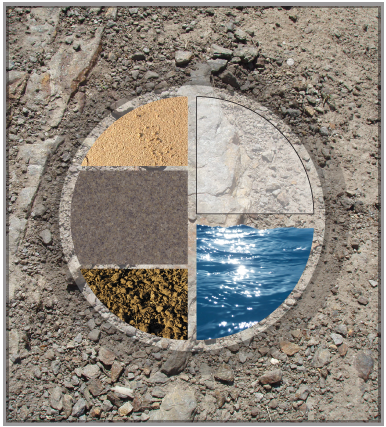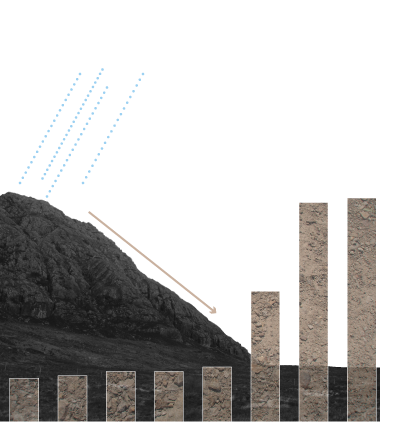
Soil is not just dirt underneath your feet! Soil is a critical part of our life cycle. Soil is old. It takes hundreds and thousands of years to create an inch of topsoil! Topsoil is the richest layer of soil, one that is full of nutrients and minerals for growing plants. Dirt, made of inorganic materials like sand, silt, and clay, is actually dead. Soil, on the other hand, although partially mixed with dead dirt, is full of life! When you walk on soil you are walking on living matter!!! The parts of soil that are alive include bacteria and other living organisms such as worms and insects. These organisms work to break down material into nutrients that are the life-giving structure of soil. Roots from plants push into the soil creating passageways for water, air and nutrients. Earthworms, rodents, snakes and insects build subterranean passages that create additional routes for water, air and bacteria to move through the layers of soil. When you hold soil in your hand you are holding living, microscopic, bacteria! A teaspoon of soil is full of more kinds of bacteria and other micro- and macroscopic organisms than there are people living on earth! In fact, although we know about 6,000 species of bacteria, there are millions we haven’t yet discovered! Bacteria in soil are key to the health of the soil and the growth of plants. Healthy soil equals healthy insects, plants, birds, food…and people!
Our life depends upon having healthy soil!
Activity 1 – Types of Soil

Different climates, different organisms, and different topographic conditions create different types of soil. Deserts and rocky mountain areas have little soil. Warm, wet climates speed up the processes of decay and change, transforming Earth’s surface and once-living organisms into topsoil. Cool, dry climates work more slowly. Steep topographic areas like mountains have less soil than flat areas. Wind and water wash away or ‘erode’ topsoil, while valleys act as collectors of soil.
To compare different types of soil, get a few small containers, a large spoon, and an egg carton to sort any large items you find in the soil. Prepare one or two jars with rubber-banded, perforated covers for worms and insects. If possible, grab a magnifying glass. Go outside. Walk to different parts of your yard, a park, a forest, a lakefront or river’s edge. Collect soil from five different sources. Bring them in and begin to inspect them. Sort similar items from others. Put bugs together. Put worms together. Put rocks and stones and twigs together. Inspect the granules and other things you find. As you work, describe your soil samples in a notebook or field journal. You will see that soil is different in different places. Take pictures of your different soil collections. Describe your sampling site as either agricultural, garden, parkland, playing field, forest, open grassy field, shoreline, industrial, constructed, or wetland. Note the soil color. Check your library for the Munsell Soil Color Chart. Use several colored pencils to show the color of the soil. Begin to collect soil samples wherever you go!
Activity 2 – Soil Color and Soil Critters

Now that you have collected and labeled different soil samples from different location, use several colored pencils to show the color of the soil.
If you have access to a Munsell Soil Color System, find which color matches your soil samples. What does the color of the soil tell us?
Look closely at your soil samples. Did you find any of the following organisms in your samples? Worms? Beetles? Flies? Larvae? Snails? Slugs? Ants? Bees and wasps? Earwigs? Spiders? Centipede? Millipedes? Take a look at the Insect Journey and draw the organism found in each color of soil you have collected.
Be a soil scientist!
Activity 3 – Life in and on soil!

Look closely. There is a lot of life in the soil! Soil is a site for producers; producers are plants that create energy using photosynthesis. Producers are the first step in the food chain. Consumers are organisms that have to eat other things to produce energy; they are the last link in the food chain. Decomposers are organisms that eat waste and turn it into nutrients that replenish topsoil. Predators are animals that feed off of insects and other animals. Herbivores eat plants, carnivores eat meat, and omnivores eat both plants and animals to survive. Soil is also very precious. Our planet is covered by oceans, lakes, and polar and desert regions. Only 7% of the earth’s surface is covered in topsoil suitable for agriculture. In the last 100 years, people have removed, buried, and destroyed topsoil under cities, highways, industrial parks, landfills, shopping centers, suburbs, and single-crop industrialized agriculture. Rebuilding nutrients in the soil is a communal undertaking. Organizations like Kiss the Groundwork to raise awareness of the importance of cultivating regenerative soils. What can you contribute? Can you compost vegetable scraps at your home? Check out NEXT.cc’s Vermiculture and get started today!
Activity 4 – Soil Filters

Soil absorbs and filters pollutants. When soil gets overloaded with pollutants and loses its ability to filter them, it becomes unhealthy. When rainwater runs from rooftops into roads and into rivers and lakes without being filtered by soils, it creates polluted water. In this activity, create 4 more replicated soil systems. Watch as the soil filters or attempts to filter pollutants. Make a list of pollutants you have around your home and school. Think about motor oil, laundry detergent, paint, insecticides, etc. Collect the following materials:
blue laundry detergent (1 ounce)
powdered cleanser (4 tablespoons)
cooking oil (1 ounce)
water - 4 cups (8 fluid ounces each)
muddy water (6 ounces)
Using a soil system for each treatment, prepare and pour the following solutions into your systems; label the ingredients for each system:
System 1: blue detergent + 6 ounces of water
System 2: powdered cleanser + 6 ounces of water
System 3: 6 ounces of plain water (best possible practice)
System 3: 6 ounces of muddy water
Predict what will happen in each soil system. Then watch and record what happens as the solution passes through the soil. Observe the water that runs through and drips into the bottom of the bottles. Reflect on what is different in each of the soil systems and why. What did you discover?
Activity 5 – Soil Testing

Plants need food (or nutrients) to grow. Plants need soil that has Nitrogen (N), Phosphorus (P), and Potash (K) to grow, just as we need food with vitamins, minerals, carbohydrates, and protein. Phosphorus is essential for healthy roots, seed and fruit development. Nitrogen creates green leaves, and Potash is essential for fruit and flower development. Plants require the correct pH level to access the Nitrogen, Phosphorus and Potash. Different plants require different pH levels so we test our soils to understand the pH level. If the pH level is too low (or acidic) we can enhance the soil with more nutrients. pH is measured on a scale of 1 to 14 with a measurement of 7.0 being neutral. A number below 7 is acidic (sour) and above 7 is alkaline (sweet). Most plants thrive between 6.2 and 7.2pH. If the soil is too acidic, the nutrients will be drained away as water flows through the soil. To reduce the acidity, you may mix in some lime. If the soil is too base or alkaline, or in other words, if there is not enough acid, then nutrients will not dissolve quickly enough to be taken up by plant roots. To reduce the alkalinity of soil, you can add some sulfur. To test the soil, you will need a Soil Testing Kit. Soil testing kits are available online or at your nearest hardware or gardening store. The simplest test has four glass tubes or vials with different colored lids and different colored tablets. While the best time to test your soil is in the spring before planting, or after the fall harvest, it is also important to test dry soil rather than wet unless it is part of a soil testing kit.
Activity 6 – Soil Systems

Soil is made of organic and inorganic material, air and water. It is a living working system. Collect cotton balls, gravel, garden soil, and grass seed. Collect one clear plastic liter bottle for each soil system. Cut the top1/3 off of one of the plastic liter bottles; remove the cap and turn the top upside down in the bottom. Place cotton balls in the bottom. These represent the spongy subsoil deep below the surface. Next place a layer of gravel as the stony layer. Cover the stony layer with a thin layer of moistened garden soil. Sprinkle grass seed and cover seed with ¼” soil. Place your soil system in a sunny windowsill. Keep the soil moist. Take a picture of your soil system each day until the grass is over 1 inch tall. You have replicated the layers of a soil system!
Activity 7 – SOIL HEALTH

Long before people farmed the land, healthy soil was created. Today with the growing human population, there is a demand for more food. production. Industrialized agriculture, as it exists, is an outdated system in many ways. It tills the ground, which destroys the soil’s natural microbial ecosystem of life. It repeats crops again and again which removes specific minerals from the topsoil reducing the variety of microbes. It throws water into the air to irrigate but it evaporates a large percentage. Farmland has been cleared of natural topsoil building flora and fauna and over-fertilized with herbicides, pesticides, and insecticides. Strategies to return the soil to its natural regenerative state include maximizing the biodiversity of life forms, and rotational crops, cover cropping between food production to restore minerals, and providing living roots in soils. Healthy soil has a healthy food web of composers and decomposers, predators and microbes, mammals, and insects. Draw the food web in healthy soil or fill it out on NEXT.cc’s Life in Soil Worksheet.
Review

- Soil is essential to our health and well being.
- Which climatic regions produce the most soil?
- Soil is full of:
- Dirt is:
- Inorganic matter in soil includes:
Explore
- 3D Printed House Made from Dirt in Italy
- Anneberg Learner Soils Lessons
- Color of Soil
- Earth’s Soils Reveal Climate, Biodiversity & Food Security Solutions
- Geology for Kids
- Kiss The Ground
- Kiss the Ground Soil Curriculum (Spanish)
- Know Your Soil World Bank pdf
- Middle School Soil Curriculum Kiss the Ground
- Munsell Soil Color Chart
- Munsell Soil Color System
- Mushrooms Support Soil Eco Systems
- Navdanya Living Soil Book
- Purdue Soil Health
- Reverse Grafitti: Art by Cleaning
- Sand Grain Gallery
- Soil Acidity
- Soil Crayons
- SOIL Cycling of Matter
- SOIL Food Web
- Soil Food Web
- Soil Health 101
- SOIL KITCHEN
- Soil NET UK
- SOIL Organism Matching
- Soil: Soiled Again
- Soil Types and Testing
- The DIRT Connecting Natural and Built Environments
- The Dirt on Soil Discovery Learning
- The Soil Solution Film Preview
- Twelve Orders of Soil Taxonomy
- Underground Adventure Photos
- USDA Soil InfoGraphics
- USDA Web Soil Survey
- Video A Grain of Sand, Dr. Gary Greenberg
- Video Dirt Cheap
- Video Life in Soil
Relate
- Adobe
- Architecture
- Biomes
- Cities
- Flowers
- Food
- Forests
- Germs
- Grass
- Grasslands
- Green Cities
- Green Dollhouse
- Green Roofs
- Insects
- Land
- Landfills
- Landscape
- Nature Play
- Plants
- Precipitation
- Rocks
- Site Analysis
- Suburbia
- Tree Identification
- Urban Agriculture
- Urban Design
- Vegetable gardens
- Vermiculture
- Vertical Farming
- Water
- Water Quality
- Watershed
- Weather


















































